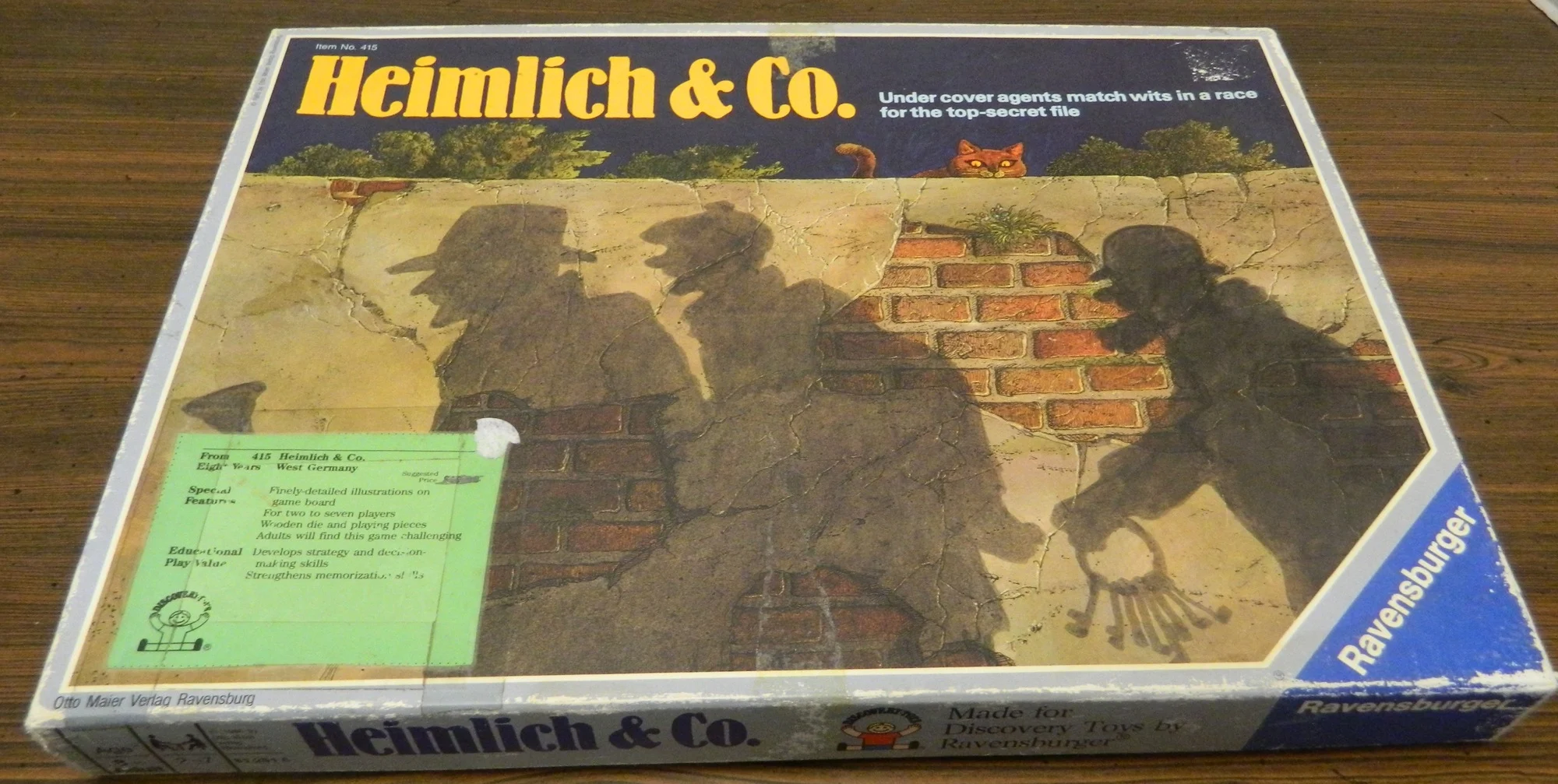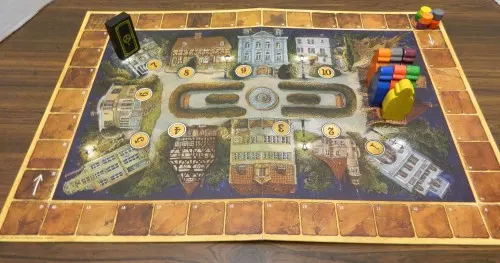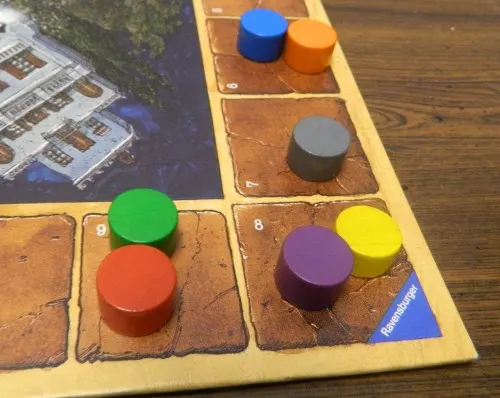How to Play
Objective
In secret help your own agent reach the finish line.
Setup
The number of agents that will be used in the game depends on how many people are playing the game.
- 2 players: 4 agents
- 3 players: 5 agents
- 4 players: 6 agents
- 5-7 players: 7 agents
The players choose which agents will be used in the game. The corresponding agent pieces are placed on the church space while the same colored score markers are put on the start space on the score track. The secret file piece is placed on the seven building.
The cards that have the same colors of the agents used in the game are shuffled and each player takes a card at random. The cards not chosen are put off to the side with no players looking at them. Each player looks at their card to figure out which color is their color for the game.
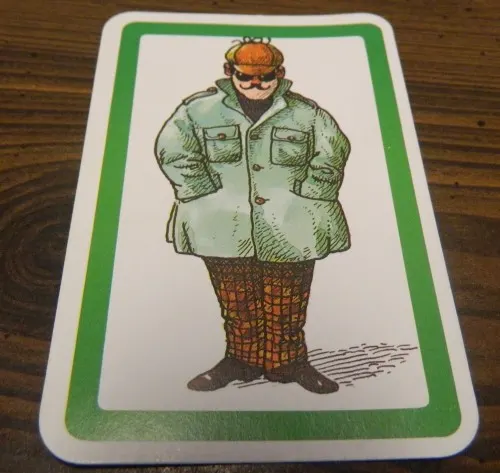
This player has drawn the green secret agent. Their goal is to help the green agent while trying to keep their secret identity from the other players.
Each player rolls the die and whoever rolls the highest number gets to be the first player.
Movement
Each player’s turn starts with them rolling the die. The player then has to choose which agents they want to move. The player can move their own agent or any of the other agents in the game. Agents move clockwise around the game board with each building counting as one space. The player has to use the whole number rolled but they can split the number rolled between as many agents as they want. For example if they roll a six they can move one agent six spaces, they can move two agents three spaces, six agents one space, one agent four spaces and another two spaces, or any other combination that adds up to six.
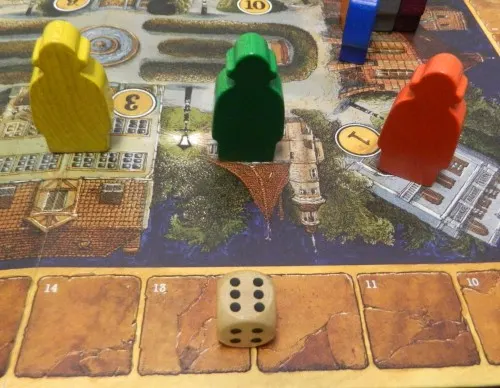
The player rolled a six. They decided to move the yellow agent three places, the green agent two places, and the red agent one place.
While moving agents players need to move their own agent into an advantageous position but they need to hide the identity of their agent or the other players can mess with their agent for the rest of the game.
Scoring
Players keep moving agents around the game board until one or more agents land on the building that contains the secret file. When this happens scoring takes place.
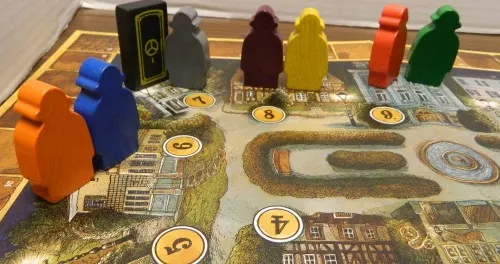
The grey agent has landed on the building with the secret file. All of the agents would score points based on the space they currently occupy. The green and red agents would get nine points, the yellow and purple agents would get eight points, the grey agent would get seven points, and the blue and orange agent would get six points.
Each agent scores points equal to the number of the building that they are on. The broken down building is worth negative three points while the church is worth zero points.
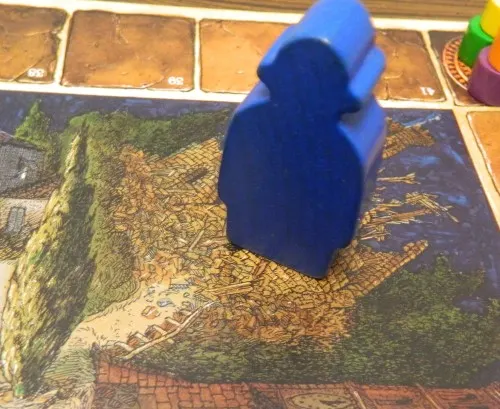
The blue agent is on the broken down building. If scoring was done while the blue agent was on this space they would lose three points.
The players move each agent’s scoring token around the score track the number of points earned.
The player whose turn resulted in scoring taking place gets to chose the next location for the secret file piece. The secret file has to be placed in an unoccupied building.
End of Game
The game ends when one or more agent’s score piece passes the finish line. Whichever agent passed the finish line wins the game. If two agents passed the finish line at the same time, whichever agent passed the finish line by more spaces wins the game. Each player then reveals which agent was theirs. If one of the players’ agent was the agent that reached the finish line, that player wins the game. If an agent that doesn’t belong to any of the players ends up winning the game, none of the players win the game.
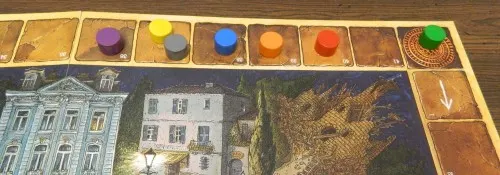
The green agent has reached the finish space. If one of the players’ secret identity was the green agent, they would win the game.
Review
Winner of of the Spiel Des Jahres (Game of the Year) in 1986, Heimlich & Co (also known as Top Secret Spies, Under Cover, or Detective & Co) is a game that I have played several times but have never reviewed before. Heimlich & Co was created by Wolfgang Kramer a winner of several Spiel Des Jahres awards. Since I have played the game several times it shouldn’t come as much of a surprise that I really like Heimlich & Co.
What I really like about Heimlich & Co is that it is such a great blend of simplicity and strategy. The game is very easy to learn since you should be able to learn how to play the game in five to ten minutes. The game has a recommended age of 8+ and that seems about right. Younger children might not understand all of the strategy behind hiding the identity of your agent but otherwise they shouldn’t have any trouble with the game. Due to its’ simplicity and strategy, Heimlich & Co is the type of game that I think would work great for gamers and non-gamers. The game is also pretty quick at around a half hour.
I really like games that have strategy but are also simple. I would rather play a game with a moderate level of strategy that is quick to pick up over a game that takes hours just to learn how to play. While Heimlich & Co is a simple game, that doesn’t mean that there isn’t strategy in the game. Most of the strategy in the game comes from trying to hide your identity while also trying to position your own agent as best as possible. While you could just keep moving your own agent, which would help you score a lot of points early, other players will figure out your identity and they will sabotage that agent for the rest of the game.
The key to the game is to be subtle with your movements in the game. You obviously need to move your own agent or you won’t win but you need to get the other players to think you are a different agent than you actually are. Your best strategy is probably to move groups of colors at the same time. This will give you one or two decoys that the other players might think are yours instead of figuring out your actual agent.
Heimlich & Co’s greatest strength is that it focuses on just one mechanic but masters that mechanic. The only mechanic in the entire game is to move pieces around the board while trying to bluff your own identity. You would think with only one mechanic that the game wouldn’t be good but it is. Figuring out how to position the pieces through movement is where the strategy in the game comes from and is why Heimlich and Co is a good game. Wolfgang Kramer found a mechanic that is fun but also simple. Having one good mechanic is better than having a bunch of mechanics that are average or bad.
Most of the complaints I see online about Heimlich and Co are either that it is too easy to figure out who the other players’ agents are and that you might as well play the game without even knowing your own identity since it doesn’t matter. I personally don’t agree with either.
If a player is too obvious with their movements it is easy to figure out their secret identity. If you are subtle with your movements though it shouldn’t be that big of an issue. Based on how you move pieces you are going to tip your hat to some of the agents that aren’t yours but you should be able to keep your identity hidden between a couple different agents. In all of the games that I have played I have had suspicions but I have never known for sure who had each agent until the final stretch. During the final stretch you need to try to score as many points as possible in order to pass the finish line so players start blowing their identities at this point in the game.
As far as just playing the game without even looking at your secret identity, I really don’t see the reasoning behind this complaint. I think this complaint comes from people playing the game too cautiously. I think this issue occurs if players are too cautious not wanting the other players to discover their identity. While you want to keep your identity secret for as long as possible, if the other players find out it is not the end of the game. If you play so conservatively that you move every agent the same number of spaces, you might as well not know your own secret identity. The key to the game is to move your agent to advantageous positions but hide it by helping other agents as well (obviously not as much as your own).
Although the game supports up to seven players I think the game would be better with three to five players. One of the things I like about the game is that there are two agents that have no affiliation to the other players. While I have yet to see one of these agents win a game before, they are a good addition to the game in my opinion since you don’t know if you are helping another player or if you are helping the random agents no one is controlling. With six or seven players you will either only have one or none of these agents and I think the game could run a little long with so many different players. I have never played the game before with more than four people though so the game may play fine with six or seven players.
One of the things I have yet to try with Heimlich & Co is the advanced rules. The advanced rules play the same for the most part with the only significant difference being the ability for each player to have the ability to try and guess the identities of the other players. Once any agent reaches or passes space 29, all of the players write down their guesses for the identities of the other players. At the end of the game each player gets an additional five points for each identity they guessed correctly. This seems like a good addition to the game since it adds more deduction to the game. It also gives players more reason to try and keep their identities secret.
The biggest problem I have with Heimlich & Co is that it sometimes relies quite a bit on the luck of the roll. While you likely won’t win or lose due to the luck of the roll, if you roll well you will have an advantage in the game. The higher the number you roll the more impact you can have on the game. If you roll a one or two you either can’t move your own agent much or you can’t hide it from the other players. If you consistently roll fives or sixes though you have more flexibility so you can hide the movements of your own agent. This won’t be the only factor that influences who ends up winning the game but if you roll low numbers you are going to have to rely on the other players moving your agent more often.
Luck also comes into the game due to turn order. This is mostly at the end of the game. If there are several agents near the finish line, the player who gets to play next has a huge advantage over the other players since they may be able to position the agents in a way for them to win the game. I have played two games where the eventual winner won because they got the last turn in the game. Another player could have won if it was their turn so the winner kind of got lucky that they got to play before the other player(s).
Another issue with Heimlich & Co is the theme. While the game has a theme about detectives/secret agents looking for evidence, it is very light and doesn’t really factor into the game. You could strip out the theme and the game wouldn’t play any differently. That is why I would say that the game is pretty abstract. If you don’t like abstract games, you may not like Heimlich & Co because it is not the type of game that you play for it’s theme. If theme is really important to you for board games, the theme might turn you off from Heimlich & Co.
Finally the components are nice. I love unique looking meeples and I really like the trench coat wearing meeples included with Heimlich and Co. For an older board game the art on the game board is also pretty nice. You don’t really need the game though to actually play Heimlich & Co. You just need some sort of board with 12 spaces, different colored pawns, some paper or cards for each color, and a die. You could easily make your own version of the game if you were so inclined. I am not saying that you should just go out and make your own copy of the game since the components that come with Heimlich & Co are nice but it wouldn’t be that hard to make your own copy of the game if you wanted to.
Final Verdict
While Heimlich & Co might sound like a very simple game, it excels because it is based on a simple but fun mechanic. You can learn the game in like five minutes and the game is simple enough that children and non-gamers can enjoy the game. Even though it is simple the game has enough strategy to keep gamers interested since you are trying to hide your true motives while still trying to put your own agent in advantageous positions. This balancing act is why I really enjoyed Heimlich Co. The only two problems I really had with the Heimlich & Co is that it relies a little too much on luck at times and the theme is a little on the light side.
If you are looking for an accessible game that still has a decent amount of strategy I think you would like Heimlich & Co. The game is on the abstract side though so if you really like a strong theme in your games it may not be for you.
If you would like to purchase Heimlich & Co, you can purchase it on Amazon here.

